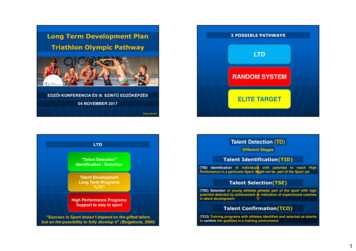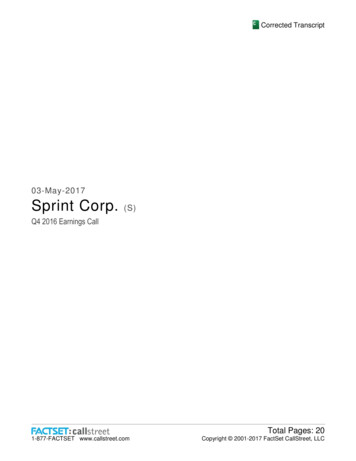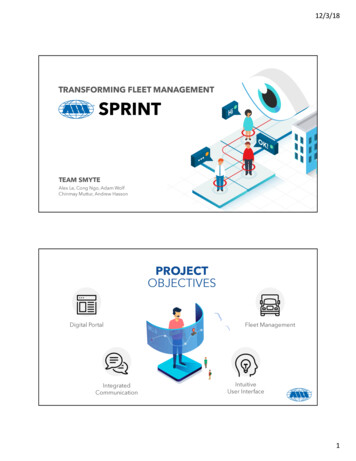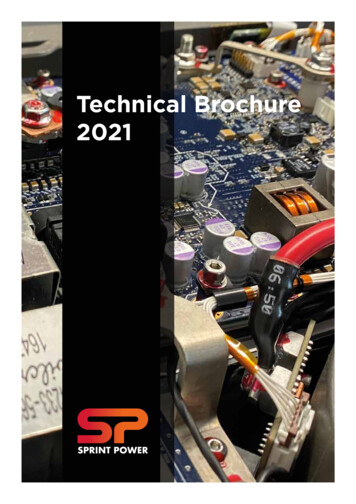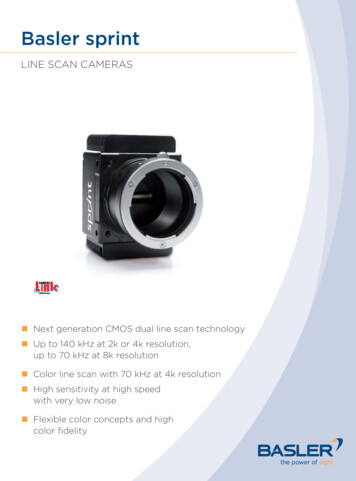
Transcription
Basler sprintLINE SCAN CAMERAS Next generation CMOS dual line scan technology Up to 140 kHz at 2k or 4k resolution,up to 70 kHz at 8k resolution Color line scan with 70 kHz at 4k resolution High sensitivity at high speedwith very low noise Flexible color concepts and highcolor fidelity
OVERVIEWFast, Faster, sprintThe Basler sprint family of line scan camerasincludes members with 2k, 4k, and 8k resolutionand different line rates. All sprint variants are basedon a next generation dual line CMOS sensordesigned exclusively for Basler.Your benefits include: Increased throughput with maximumline rates of up to 140 kHzThe Basler sprint is aimed at applications wherehigh sensitivity, excellent image quality, and thehighest speed are required. This speed and imagequality let sprint camera users increase efficiencyand throughput in many vision applications. Higher sensitivitysprint CMOS Sensor Technology Easy integration into your applicationTo reach Basler’s high goals for the sprint sensor, thepositive properties of current sensor technologieswere combined. The well-known image quality ofCCD sensors was combined with the high speedof CMOS to achieve a “best of both worlds” result.The sprint development project resulted in a uniquesensor design with a high QE (quantum efficiency)of up to 60%, a fill factor of 100%, and a very highSNR (signal-to-noise ratio) at low light conditions.This means that users will see very low noise levelsand unique speed levels. A maximum line rate of140 kHz can be reached at either 2k or 4k resolution.With 8k resolution a line rate of up to 70 kHz can bereached. The fact that there is no gap between thetwo active lines in the sensor makes it easy to fitthe camera into both existing and new applicationswith no spatial artifacts. 100% quality checked and calibrated togive you consistent performance andreliability More capable vision-based inspection AOI (area of interest) with linearspeed increase2
OVERVIEW Shading correction (flat field correction)DSNU (dark signal non-uniformity) and PRNU(photo response non-uniformity) can be performedto correct for the non-homogeneous behavior oflighting, optics, and the sensor that can be presentin real world applications. Shading or vignettingcaused by lenses can be compensated by theenhanced shading correction (ESC). The widerange of the ESC is very helpful for imageprocessing, especially with larger sensors andlenses with shorter focal lengths (please ask for‚ESC models‘).The dual line sensor offers high flexibility so thatthe sprint can meet a wide variety of applicationrequirements and can be easily integrated. Someof the main unique properties and features ofthe Basler sprint are: AOI (area of interest) with linear speed increaseThe AOI feature lets you focus precisely on the areaof an object that is important to you. This meansthat the amount of data transmitted by the camerawill be reduced and that the image processingapplication in your host PC will not be overloadedwith unnecessary data. In addition, you may see alinear increase in the camera’s speed by reducingthe AOI. ColorA Bayer pattern filter is used to create the colorversion of the sprint. One line in the sensor reportsred and green information and the second linereports green and blue information. Image datain a raw format is transferred to the frame grabberwhere color processing happens in a fast, reliableway similar to common color area scan cameras.Several color creation schemes can be implemented.Depending on the application needs, the activecolor concept can focus on speed and reducingthe amount of data, or it can focus on higher colorfidelity. For higher color fidelity, each object lineis scanned twice, thus two times color informationis available for each image point. This approachhas a big advantage because standard lensesand frame grabbers can be used. Because thereis no gap between the sensor’s two active lines,adapting the camera to your application/object iseasy and no spatial correction is needed (see theBayer pattern graphic). Time delayed line sumThis feature uses the dual line sensor to scaneach object line twice in a time delayed fashion.The double information is combined in the sprint’sinternal memory and this technique doubles thesprint’s sensitivity. It also significantly reducesnoise and results in a 3 dB increase in the SNR. Time delayed line averagingWith this feature, time delayed line summing isperformed and then the doubled information isaveraged. The advantages are an increase of3 dB in the SNR and an increase of 3 dB in thedynamic range. BinningBoth horizontal and vertical binning are available.Either two pixels or four pixels can be binnedtogether (see the graphics illustrating binning).RGRGRGRGRGRGGBGBGBGBGBGBBayer pattern filter – sensor has no gap between pixels or linesVertical BinningHorizontal and Vertical Binning3
TECHNICAL DETAILSSpecificationsspL204839kcBasler 4870kcspL2048140kmColorMonoCameraSensor Size(pixels per line)2048Sensor TypeDual Line CMOSMono / ColorColorMonoColorMono10 m x 10 mPixel SizeCamera LinkPixel Clock*40/80 MHzMax. DataSpeed160 MHz160 MHz320 MHz160 MHz320 MHz320 MHzMax. Line Rate38.6 kHz50 kHz50 kHz70 kHz70 kHz140 kHz2/3/4/6/82/4/8Pixel DepthsSelectable 8 bit, 10 bit, or 12 bitVideo OutputFormat (taps)*2/32Syncronization2/3/4/6/82Via external signal or free runExposureControlEdge-controlled, level controlled, or programmableMechanical /ElectricalHousing Size(L x W x H)48 mm x 87 mm x 62 mmHousingTemperatureUp to 50 CLens MountC-Mount, F-mount, M42PowerRequirements12 VDC ( 10%), max. 6.0 W @ 12 VDCWeight (typical)360 g (without F-Mount adapter)ConformityCE, FCC, RoHSSpecifications are subject to change without prior notice.For detailed technical information, see the camera User’s Manual that can be found at www.baslerweb.com/manuals* can be changed via our configurations software CCT , that can be found at www.baslerweb.com/downloadsDimensions (in mm)4x M41595 53.54874848491004x M492102
TECHNICAL DETAILSSpecificationsBasler 9650kcspL409670kmspL4096- aSensor Size(pixels per line)4096Sensor TypeMono / ColorDual Line CMOSMonoColorMonoColorMono10 m x 10 mPixel SizeCamera LinkPixel Clock*40/80 MHzMax. DataSpeed160 MHz320 MHz320 MHz640 MHz320 MHz640 MHz640 MHz640 MHzMax. Line Rate38.6 kHz38.6 kHz50 kHz50 kHz70 kHz70 kHz140 kHz140 kHz2/3/4/6/82/4/82/3/4/6/8Pixel DepthsVideo OutputFormat (taps)*SyncronizationExposureControlSelectable 8 bit, 10 bit, or 12 bit2/42/3/4/6/82/4/82/3/4/6/82/4/8Via external signal or free runEdge-controlled, level controlled, or programmableMechanical /ElectricalHousing Size(L x W x H)48 mm x 87 mm x 62 mmHousingTemperatureUp to 50 CLens MountF-mount, M42PowerRequirementsWeight (typical)12 VDC ( 10%), max. 10.0 W @ 12 VDC360 g (without F-Mount adapter)ConformityCE, FCC, RoHSSpecifications are subject to change without prior notice.For detailed technical information, see the camera User’s Manual that can be found at www.baslerweb.com/manuals* can be changed via our configurations software CCT , that can be found at www.baslerweb.com/downloads5
TECHNICAL DETAILSSpecificationsNEWBasler pL8192-70kmCameraSensor Size(pixels per line)8192Sensor TypeMono / ColorDual Line CMOSColorColorCamera LinkPixel Clock*ExposureControl70 kHz640 MHz38.6 kHzPixel DepthsSyncronization50 kHz40/80 MHzMax. Data SpeedVideo Output Format(taps)*Mono10 m x 10 mPixel SizeMax. Line RateMono38.6 kHzSelectable 8 bit, 10 bit, or 12 bit2/3/4/6/82/3/4/6/82/4/82/4/8Via external signal or free runEdge-controlled, level controlled, or programmableMechanical /ElectricalHousing Size(L x W x H)49 mm x 102 mm x 102 mmHousing TemperatureUp to 50 CLens Mount AdapterInterfaceV-92 mount for specific lens mount adapterLens Mount AdapterUnifoc 100/95/V-Basler helical mount, M58 x 0.75/V-Basler lens mountPower Requirements12 VDC ( 10%), max. 13.5 W @ 12 VDCWeight (typical)580 gConformityCE, FCC, RoHSSpecifications are subject to change without prior notice.For detailed technical information, see the camera User’s Manual that can be found at www.baslerweb.com/manuals* can be changed via our configurations software CCT , that can be found at www.baslerweb.com/downloads** with Color Improvement Feature, without Line Stamp Feature6
OVERVIEWsprint Housing ConceptThe most important benefits offered by CameraLink are:Another important characteristic of Basler’s sprintseries is the innovative housing and cooling concept.The sensor module and the camera housing havebeen integrated as a single unit to optimize coolingand to reduce heat induced noise to a minimum.The sensor and the electronics that control thesensor are part of a ceramic module. The ceramicmodule is directly attached (both physically andthermally) to a heat sink system that pipes heatdirectly to the outside of the camera. An accepted and proven communicationsstandard for vision technologies (cameras andframe grabbers) A simple, standardized cable concept Particularly suitable for high data rates Standardized protocols for several types of imagedata transfer, for example, 2, 4, or 8 tap cameraoutput and 8 bit, 10 bit, or 12 bit pixel depthTo achieve the smallest possible tolerances in sixdirections, the sensor is positioned in the cameraby a specially designed automatic positioning tool(see the graphic showing the up, down, left, right,rotate, and tilt directions). Maintaining the very smalltolerances helps to ensure that each camera behavesin the same way. It also makes it easier for usersto adjust the sprint to their application and to havea sharp focus over the entire sensor surface. Serial communications to the camera via a porton the frame grabberOne main advantage of the Camera Link standard isthat numerous frame grabbers produced by manydifferent vendors are compatible with the Baslersprint series.Typical ApplicationsBasler sprint cameras are perfect for usein applications such as: OCT (Optical Coherence Tomography) Print inspectionSensor module positioning Web inspection of paper, foil, wood veneers,etc.Camera Link Interface Document scanning and postal sortingCamera Link is a camera communications interfacedesigned for vision applications in science andindustry. Camera Link was first established in 2000by Basler and other leading companies in the machinevision arena. Camera Link enables a maximum datatransmission rate of up to 800 MB per seconddepending on the configuration. The CameraLink interface is used to connect a camera to acompatible frame grabber in a host PC. The framegrabber collects and evaluates data from thecamera. Food inspection Surface inspection of printed circuit boards,flat panels and displays, semiconductors, etc.7
OTHER INFORMATIONHow Does Basler Measureand Define Image Quality?Basler is leading the effort to standardize imagequality and sensitivity measurement for camerasand sensors. We are giving the EMVA 1288 standardour strongest support because it describes a unifiedmethod to measure, compute, and present thespecification parameters for cameras and imagesensors. Our cameras are characterized and measuredin 100% compliance with the EMVA 1288 standard.Measurement reports can be downloaded fromour website.How Does Basler Ensure Superior Qualityand Reliable High Performance?Our approach to quality assurance is rigorous:we continually audit all facets of our business toguarantee performance, increase efficiency andreduce costs for our customers. We are compliantwith all major quality standards including ISO 9001,CE, RoHS, and more. To ensure consistently highproduct quality, we employ several quality inspectionprocedures during manufacturing.Every Basler camera is subjected to exhaustiveoptical and mechanical tests before leaving thefactory. We have developed a unique combinationof optics, hardware, and software tools that canquickly and efficiently calibrate a camera andmeasure its performance against a set of standardperformance criteria. Regardless of what technologyor camera model you choose you can be assuredof consistent performance.3-Year WarrantyBasler offers a 3-year warranty for our cameras.We make this unprecedented promise becausewe have unparalleled confidence in our products.We continually reinvest in research, developmentand superior manufacturing capabilities so thatour customers can fully rely on the products wemanufacture.About BaslerFounded in 1988, Basler is a leading globalmanufacturer of high quality digital cameras forindustrial, medical, traffic and video surveillanceapplications. The company employs more than 400people at its headquarters in Ahrensburg, Germanyand subsidiaries in the United States and Asia.Basler’s portfolio of products offers customersthe vision industry’s widest selection of industrialand network cameras. Today it includes some 300models – and it’s still growing. We’re committed todeveloping technology that drives business resultsfor our customers: cameras that are easy to use,easy to integrate, and deliver an exceptional price/performance ratio. Basler AG, No. 11, 01/2014Basler AGGermany, HeadquartersUSASingaporeTel. 49 4102 463 500Tel. 1 610 280 0171Tel. 65 6367 1355Tel. 886 3 558 3955Fax 49 4102 463 599Fax 1 610 280 7608Fax 65 6367 1255Fax 886 3 558 comChina (Shanghai)China (Shenzhen)KoreaTel. 86 21 6230 2160Tel. 86 181 2395 6667Tel. 82 70 7136 3114Fax 86 21 6230 0251Fax 86 21 6230 0251Fax 82 70 7016 an
The Basler sprint is aimed at applications where high sensitivity, excellent image quality, and the highest speed are required. This speed and image quality let sprint camera users increase efficiency and throughput in many vision applications. sprint CMOS Sensor Technology To reach Basler's high goals for the sprint sensor, the
